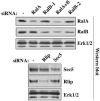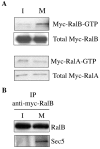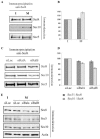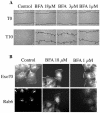RalB mobilizes the exocyst to drive cell migration
- PMID: 16382162
- PMCID: PMC1346891
- DOI: 10.1128/MCB.26.2.727-734.2006
RalB mobilizes the exocyst to drive cell migration
Abstract
The Ras family GTPases RalA and RalB have been defined as central components of the regulatory machinery supporting tumor initiation and progression. Although it is known that Ral proteins mediate oncogenic Ras signaling and physically and functionally interact with vesicle trafficking machinery, their mechanistic contribution to oncogenic transformation is unknown. Here, we have directly evaluated the relative contribution of Ral proteins and Ral effector pathways to cell motility and directional migration. Through loss-of-function analysis, we find that RalA is not limiting for cell migration in normal mammalian epithelial cells. In contrast, RalB and the Sec6/8 complex or exocyst, an immediate downstream Ral effector complex, are required for vectorial cell motility. RalB expression is required for promoting both exocyst assembly and localization to the leading edge of moving cells. We propose that RalB regulation of exocyst function is required for the coordinated delivery of secretory vesicles to the sites of dynamic plasma membrane expansion that specify directional movement.
Figures







Similar articles
-
Ral GTPases regulate exocyst assembly through dual subunit interactions.J Biol Chem. 2003 Dec 19;278(51):51743-8. doi: 10.1074/jbc.M308702200. Epub 2003 Oct 2. J Biol Chem. 2003. PMID: 14525976
-
Distinct roles of RalA and RalB in the progression of cytokinesis are supported by distinct RalGEFs.EMBO J. 2008 Sep 17;27(18):2375-87. doi: 10.1038/emboj.2008.166. Epub 2008 Aug 28. EMBO J. 2008. PMID: 18756269 Free PMC article.
-
Ral-regulated interaction between Sec5 and paxillin targets Exocyst to focal complexes during cell migration.J Cell Sci. 2008 Sep 1;121(Pt 17):2880-91. doi: 10.1242/jcs.031641. Epub 2008 Aug 12. J Cell Sci. 2008. PMID: 18697830 Free PMC article.
-
Ral GTPases: corrupting the exocyst in cancer cells.Trends Cell Biol. 2005 Jun;15(6):327-32. doi: 10.1016/j.tcb.2005.04.002. Trends Cell Biol. 2005. PMID: 15953551 Review.
-
A family affair: A Ral-exocyst-centered network links Ras, Rac, Rho signaling to control cell migration.Small GTPases. 2019 Sep;10(5):323-330. doi: 10.1080/21541248.2017.1310649. Epub 2017 May 12. Small GTPases. 2019. PMID: 28498728 Free PMC article. Review.
Cited by
-
Exo70 generates membrane curvature for morphogenesis and cell migration.Dev Cell. 2013 Aug 12;26(3):266-78. doi: 10.1016/j.devcel.2013.07.007. Dev Cell. 2013. PMID: 23948253 Free PMC article.
-
An exocyst complex functions in plant cell growth in Arabidopsis and tobacco.Plant Cell. 2008 May;20(5):1330-45. doi: 10.1105/tpc.108.059105. Epub 2008 May 20. Plant Cell. 2008. PMID: 18492870 Free PMC article.
-
PKC and the control of localized signal dynamics.Nat Rev Mol Cell Biol. 2010 Feb;11(2):103-12. doi: 10.1038/nrm2847. Nat Rev Mol Cell Biol. 2010. PMID: 20094051 Review.
-
Overexpression of RalBP1 in colorectal cancer is an independent predictor of poor survival and early tumor relapse.Cancer Biol Ther. 2012 Jun;13(8):694-700. doi: 10.4161/cbt.20087. Epub 2012 Jun 1. Cancer Biol Ther. 2012. PMID: 22549157 Free PMC article.
-
RalA and RalB proteins are ubiquitinated GTPases, and ubiquitinated RalA increases lipid raft exposure at the plasma membrane.J Biol Chem. 2012 Aug 24;287(35):29397-405. doi: 10.1074/jbc.M112.357764. Epub 2012 Jun 14. J Biol Chem. 2012. PMID: 22700969 Free PMC article.
References
-
- Bhattacharya, M., P. H. Anborgh, A. V. Babwah, L. B. Dale, T. Dobransky, J. L. Benovic, R. D. Feldman, J. M. Verdi, R. J. Rylett, and S. S. Ferguson. 2002. Beta-arrestins regulate a Ral-GDS Ral effector pathway that mediates cytoskeletal reorganization. Nat. Cell Biol. 4:547-555. - PubMed
-
- Bretscher, M. S., and C. Aguado-Velasco. 1998. Membrane traffic during cell locomotion. Curr. Opin. Cell Biol. 10:537-541. - PubMed
-
- Brymora, A., V. A. Valova, M. R. Larsen, B. D. Roufogalis, and P. J. Robinson. 2001. The brain exocyst complex interacts with RalA in a GTP-dependent manner: identification of a novel mammalian Sec3 gene and a second Sec15 gene. J. Biol. Chem. 276:29792-29797. - PubMed
Publication types
MeSH terms
Substances
LinkOut - more resources
Full Text Sources
Molecular Biology Databases
